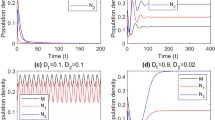Abstract
A model with time delay is considered for a predator-prey system. Here, a single species disperses between n patches of a heterogeneous environment with barriers between patches while a predator does not involve a barrier between patches. It is shown that the system is permanent under some appropriate conditions, and sufficient conditions are established for the global asymptotic stability of the positive equilibrium of the system.
Similar content being viewed by others
References
E. Beretta and Y. Takeuchi, Global stability of single-species diffusion models with continuous time delays. Bull. Math. Biol.,49 (1987), 431–448.
W.C. Chewning, Migratory effects in predation prey systems. Math. Biosci.,23 (1975), 253–262.
H.I. Preedman, Single species migration in two habitats: persistence and extinction. Math. Model.,8 (1987), 778–780.
H.I. Freedman, B, Rai and P. Waltman, Mathematical models of population interactions with dispersal II: differential survival in a change of habitat. J. Math. Anal. Appl.,115 (1986), 140–154.
H.I. Freedman and Y. Takeuchi, Global stability and predator dynamics in a model of prey dispersal in a patchy environment. Nonlinear Anal.,13 (1989), 993–1003.
H.I. Freedman and Y. Takeuchi, Predator survival versus extinction as a function of dispersa; in a predator-prey model with patchy environment. Appl. Anal.,31 (1989), 247–266.
H.I. Freedman and P. Waltman, Mathematical models of population interaction with dispersal I: stability of two habits with and without a predator. SIAM J. Appl. Math.,32 (1977), 631–648.
J.K. Hale and P. Waltman, Persistence in infinite-dimensional systems. SIAM J. Math. Anal.,20 (1989), 388–395.
A. Hastings, Dynamics of a single species in a spatially varying environment: the stabilizing role of high dispersal rates. J. Math. Biol.,16 (1982), 49–55.
R.D. Holt, Population dynamics in two patch environments: some anomalous consequences of optional habitat selection. Theor. Pop. Biol.,28 (1985), 181–208.
C.B. Huffaker and C.E. Kennett, Experimental studies on predation: predation and cyclamen-mite population on strawberries in California. Hilgardia,26 (1956), 191–222.
N.R. LeBlond, Porcupine Caribou Herd. Canadian Arctic Resources Com., Ottawa, 1979.
V. Lakshmikantham and S. Leela, Differential and Integral Inequalities (Vols. I and II). Academic Press, New York, 1969.
S.A. Levin, Spatial patterning and the structure of ecological communities. Some Mathematical Questions in Biology VII, A. M. S. Providence, R. I., 1976.
S.A. Levin, Dispersion and population interactions. Am. Nat.,108 (1984), 201–228.
Y. Kuang, Delay Differential Equations with Applications in Population Dynamics. Academic Press, New York, 1993.
Y. Kuang and Y. Takeuchi, Predator-prey dynamics in models of prey dispersal in two patch environments. Math. Biosci.,120 (1994), 77–98.
L.A. Segal and S.A. Levin, Application of nonlinear stability theory to the study of the effects of diffusion on predator-prey interactions. Topics in Statistical Mechanics and Biophysics: A Memorial to Julius L. Jackson (ed. W. D. Lakin), AIP Conf. Proc, No. 27, Amer. Inst. Phys., New York, 1976, 123–152.
J.F. Selgrade, Asymptotic behavior of solutions to a single loop positive feedback system. J. Differential Equations,38 (1980), 80–103.
J.F. Selgrade, On the existence and uniqueness of connecting orbits. Nonlinear Anal.,7 (1983), 1123–1125.
Y. Takeuchi, Global stability in generalized Lotka-Volterra diffusion systems. J. Math. Anal. Appl.,116 (1986), 209–221.
Y. Takeuchi, Diffusion effect on stability of Lotka-Volterra models. Bull. Math. Biol.,48 (1986), 585–601.
R.R. Vance, The effect of dispersal on population stability in one-species, discrete-space population growth models. Am. Nat.,123 (1984), 230–254.
W.D. Wang and Z.E. Ma, Asymptotic behavior of a predator-prey system with diffusion and delays. J. Math. Anal. Appl.,206 (1997), 191–204.
Author information
Authors and Affiliations
About this article
Cite this article
Qiu, L., Mitsui, T. Predator-prey dynamics with delay when prey dispersing inn-patch environment. Japan J. Indust. Appl. Math. 20, 37 (2003). https://doi.org/10.1007/BF03167461
Received:
Revised:
DOI: https://doi.org/10.1007/BF03167461




